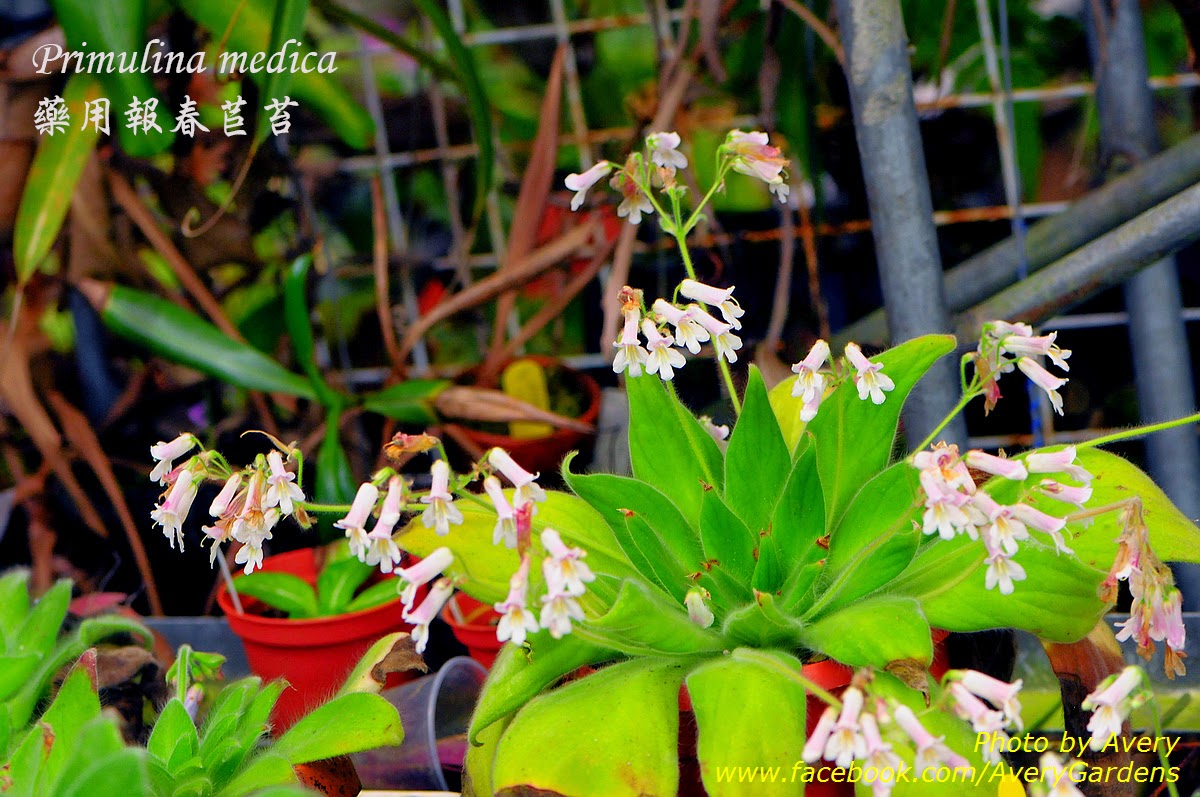Primulina fimbrisepala 'Universe' (syn. Chirita fimbrisepala 'Universe')
螞蝗七(報春苣苔) '宇宙'
I received this plants one and a half year ago as a small juvenile plant. Although the plant is small, leaf variegation is so special that hasn't been seen before. I put it in a shaded place under my bench and it gradually grows up to a much bigger size while the leaf variegation looks more attractive. My plant finally flowers recently. I really hope that I can make use of this special clone to breed some new Primulina hybrids with nice leaf pattern.
As the plant is so unique and raised a lot of attention, I name this special clone of as Primulina fimbrisepala 'Universe'.
Existing registration rules in TGS is quite loose and it is not necessary for breeders to list all parantages of their hybrids and anyone can give his plant a name if he considers it special. If I name my plant following the rules of TGS, my plant is going to be Primulina 'Universe'. However, only people that follows its story knows this is actually a special variety of Primulina fimbrisepala. It is complicated for new comers to know history of plants that registered and plan their own breeding according to past experience of breeders.
I don't know whether my concept can be wildly accepted in the Gesneriad field. I have been growing orchids for many years. Orchids hybridization is strict and only one Hybrid name will be given in the cross of 2 plants, say A and B. Both A x B and B x A = C no matter all plants raised from the same seed pod are different. Even remake of the same cross by other plants A and B will not be given another name. People might wonder how plants of different flowers can be differentiated. In this case, horticultural variety will be used. Let's take a Primulina cross as an example. Say there are 2 different clones was raised from the same seed pod of hybrid Primulina C that worth merits of naming. One is Yellow and the other is Red. In this case, these 2 clones will be given the name Primulina C 'Yellow' and Primulina C 'Red'. There is no need for further registration of these horticultural variety or cultural variety (cv.)
New breeders can now trace what parantages of Primulina C are and figure out such breed of A and B could yield flowers with yellow and red color. Relations of A, B, C and their different colored offsprings are clear.
對我來說中文輸入很吃力…如果博文有中文當然最好,我就盡力而為吧…不過以後大概還是以英文為主吧…畢竟速度差N倍,尤其以電腦鍵盤來說…
這棵傢伙是2012年底拿到的,第一張圖就是當初的樣子,雖然又小又破爛,還是能看出是螞蝗七,只是葉子上的斑紋很驚人,已經超越我手上其他的斑葉品種太多了
第二張圖是種了一年之後的成果,新葉完全蓋過了老葉,植株也長大了好幾倍,那時候我一直在想,如果這個斑能用在配種上多好…今年三月這種機會來了, 做了一些一代,二代和多代的交配,就看看這個體能否突破報春雜交不孕的魔咒
再下來就是這棵花的命名了,首先聯想到的是科幻片太空船光速航行時的影像,也像宇宙的星雲,後來覺得這種獨特的斑紋應該經得起永恆的時間考驗,就像永恆的宇宙一樣,那索性簡單点,就叫宇宙好了
如何用現在苦苣苔協會的準則,只要有人覺得自己手上的花有特殊之處就可以申請登錄; 無論是原生種的變種,同一果莢出但是表現不一樣的兄弟株,親本不明的雜交種等等地位是同等的
這種制度的確鼓勵了育種者實踐配種,然而當你搜尋TGS的品種名單,你會發現绝大多數的品種都不能查到其上兩代的資料,相關圖片也不齊全,搞不好名字不同的兩個品種其實就是同樣的交配,一個父本寫不詳,另一個可能就母本不詳,即使多細心認真的玩家也不太能透過這種登錄制度獲得有用的資料
因為接觸蘭花比較長時間,對蘭花登錄認識多一些,以雜交種為例,親本A和B交出了C,無論是 A x B 或者是 B x A,一概只能登記一個名字,同一果莢出的不同個體,或者用其他 A 和 B 的不同個體出的後代均同名,所有同親本表現不同的個體以園藝變種或栽培變種分辨,不需要重覆登錄; 舉個例子,A x B = C,同一批次出了紅、黄、紫三個值得冠名的個體,以蘭界的命名则為 C'紅', C'黃' 和 C'紫' 這樣子,玩家透過登錄制度就能清楚知道,不論他看到的是紅黃還是紫,他們都是 C 都是 從 A 交配 B 而來,這兩者的交配能出幾個不同顏色,從而計劃自己的交配方向。假如以苦界的登記方式,你可能只可以知道 A, B, C 的長相,不一定能知道他們的親本所屬
Original juvenile plant of Primulina fimbrisepala 'Universe' received end of 2012
Well grown plant of Primulina fimbrisepala 'Universe' in late 2013
 Flower of Primulina fimbrisepala
Flower of Primulina fimbrisepala 'Universe' flower on 22.3.2014















A1.jpg)
+A1.jpg)
+A1.jpg)



















